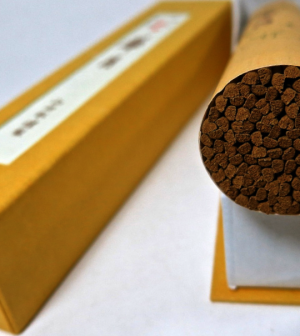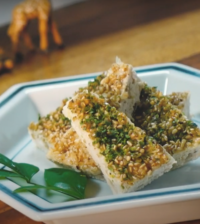- Belgium comes to Yamashita Park
- Residential Villa in Phuket Entices Remote Workers With Long-Stay Rates
- Rare pieces of French glass art at the Mirai Museum of Art
- Feast on fresh fish and seafood at the 2024 ‘Sakana’ Festival
- Would you like to ride in a Louis Vuitton gondola lift?
- Naked Snow Aquarium
- Festive lights at Yomiuriland will get you feeling the holiday vibes
Listening to incense

When most Westerners think of incense, they envision lighting up thin, sparkler-length, pungent sticks or powdery, dense and colorful cones of our favorite aroma, then placing them in a myriad of holders, from wooden boxes to ceramic or metallic burners, as the trails of smoke waft through the air, enveloping us in exotic floral, spiced or wooden fragrances. For us, incense may accompany a bath or some exercise, or we may use it for atmosphere when kicking back, and relaxing with friends over a bottle of wine, or perhaps a candlelit dinner with a loved-one. And sometimes, we even use it to cover up other, less-desirable odors.
Who among its contemporary users has not heard of nag champa, sandalwood, jasmine or musk? Who among its enthusiasts has not frequented the hippy-esque stores selling Guatemalan clothing, jewelry handmade from crystals and rare stones, woven hacky sacks, Peruvian pan flutes and hemp wallets, only to discerningly smell the wide variety of aromatic choices hailing from around the world?
But do the names kyara, rakoku, manaban, manaka, sasora and sumotara ring any bells?
If you are a practitioner or aficionado of the Japanese incense ceremony, then you will immediately recognize them as the six venerated categories of incense woods that among them share sweet, sour, hot, salty and bitter fragrant qualities.
Koh-doh (the incense ceremony as it is more commonly known) or mon-koh, literally ‘listening to incense’, has become a highly refined art that has been handed down for centuries.
Originating sometime between the 14th and 15th centuries C.E., and brought to Japan by way of India, Thailand and eventually Korea as Buddhism spread, the Japanese incense ceremony developed into a unique and secular appreciation tied closely to literature, that is often enjoyed through kumikoh or incense games, of which there are more than 200, and that are a social vehicle for incense appreciation.
“By listening to incense, we feel the story”, says Eriyo Watanabe, the Director of the Center for Arts and Wellness, located in Setagaya-ku, Tokyo.
“The games help (us) to feel the profundity of classical Japanese literature (such as The Tale of Genji), and of the incense, at the same time.”
But however classical this ceremony is, Watanabe has taken a more contemporary approach to this ancient tradition. Having lived overseas for many years, and believing as she does that most Japanese people tend to be very classical thinkers, she describes herself as a more ‘cosmopolitan’ practitioner.
“I think what I am doing is very unusual. We live in the 21st century so I want to use something I can relate to,” she says, describing her use of more modern literature to help her mostly foreign clientele better understand and enjoy her ceremonies.
Watanabe further explains that mon-koh encompasses mindful, directed and attention to the fragrance of each wood. One is supposed to remain completely open to each fragrance in a relaxed and selfless manner, to explore the world of scent and feel a sense of unity.
“It looks very simple, but it’s deep,” she adds.
During these games, each sample of incense is joined to a part of a poem or literary passage, the goal of which is to try and remember which incense is which – mo mean feat, even for the serious practitioner.
Ceremoniously
But before starting to listen, several indispensable items are required: the incense bowl, a non-aromatic white ash, some odorlesscharcoal, a set of special utensils, a mica (shiny silica mineral) plate and a selection of incense woodchips.
Traditionally performed in a Japanese-style tatami room, ten participants (the ceremony’s optimum number) sit on the floor in a U-shape facing the teishu (the talker) and komoto
(incense presenter) who lead the ritual.
Following a brief tea service and after the incense is initially sampled by all, the komoto prepares a cup of rice ash in which a piece of hot, bamboo charcoal is buried, over which, is placed the small mica plate. A tiny piece of wood is laid on the plate, from which the fragrance emanates. But contrary to contemporary usage, teh incense is not burned, but indirectly heated from below, releasing its aroma in a smokeless manner.
The source of the fragrance is the tree resin from which the incense is made, and in Asian cultures, it is believed that this essense is the soul or the spirit, and can transcend the the borders of life and death, as well as time and space, to communicate with deities or souls in the spiritual world.
“Incense is a tool to take your prayers to the heavens. I believe that it helps you communicate with the Gods,” she says.
After the komoto enjoys a several deep inhalations, the koh (incense) is passed either to the right or the left, depending on the school of thought you subscribe to. If honored guests are present, the koh is passed in their direction out of respect. The ceremony continues until everyone has had a turn, and whereupon the komoto starts anew, with another similar, yet distinct wood silver. The purpose of the whole exercise is to teach you to recognize even subtle differences, a key element in the appreciation of Japanese artistry and of the culture itself.
The pursuit of mastery
It is said that to perfect the Japanese tea ceremony takes 15 years of disciplined study. To become a kodo master takes 30 years or more, and even those who technically are masters, believe that their pursuit is lifelong, during which they continuously strive to both re-awaken and train their olfactory senses to discern between different scents of aloe woods, and to perfect the hosting of the kodo ceremony.
“To become a master, you have to memorize those hundred games. You have to know them all, and that takes dozens of years,” Watanabe says with a laugh. “I don’t think I can say I am a master in the proper way…but I do prepare for the ceremony in the traditional way, with authentic ceremonial incense.”
And while anyone can practice kodo as simply or as lavishly as they want, with friends in the privacy of their own home using simple household items or, studying with a Japanese master (of which Watanabe believes there are only about twelve in Japan), in a dedicated space, using formal, ceremonial instruments, this elegant, uncomplicated art form is immediately enjoyable by anyone, offering everyone the simple pleasure of social entertainment coupled with serene moments of respite from the demands of everyday life; a time, place and space to unwind and the chance to enjoy boththe simplicity and the complexity of your sense of smell.
To attend an incense ceremony to create your own original, blended sachets and incense sticks, or for a calligraphy lesson at the Center for Arts and Wellness, visit www.arts-wellness.com











